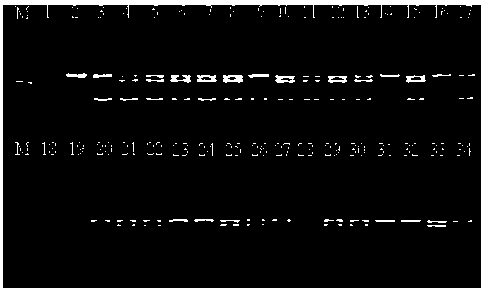Triple PCR detection method for rapidly distinguishing non-LP (legionella pneumophila), LP and LP I
A detection method and technology for Legionella, which is applied in the field of multiplex PCR detection of Legionella, can solve the problems of uncertainty, multiple cross-reactivity, and doubtful Legionella colonies cannot be finally identified, and achieves low cost, accurate and reliable results, The effect of the simple method
- Summary
- Abstract
- Description
- Claims
- Application Information
AI Technical Summary
Problems solved by technology
Method used
Image
Examples
Embodiment 1
[0017] Example 1 A triple PCR detection method for rapidly distinguishing non-pneumophilic, pneumophilic and pneumophilic type 1 Legionella, the steps are:
[0018] 1. Prepare a PCR template, pick a suspicious single colony to be detected and put it in 0.5mL sterilized nuclease-free deionized water to prepare a bacterial suspension, boil it at 100°C for 15min, and cool it for later use.
[0019] 2. Primer sequence:
[0020] 16S rRNA gene: upstream primer 5'-AAGATTAGCC TGCGTCCGAT-3', downstream primer 5'-GTCAACTTAT CGCGTTTGCT-3', the expected length of the amplified fragment is 654 bp;
[0021] danJ gene: upstream primer 5'-AGGTGGTTTT GGCGGATTTG G-3', downstream primer 5'-TGAATTCTGA CTTGCCCCAT G-3', the expected length of the amplified fragment is 285 bp;
[0022] ORF9 gene: upstream primer 5'-CAGGATTACC GCTCATTATT G-3', downstream primer 5'-GTAATTCCCA GCCATTTACC AGATC-3', the expected length of the amplified fragment is 561 bp.
[0023] 3. PCR reaction system: 1.6 μL d...
PUM
 Login to View More
Login to View More Abstract
Description
Claims
Application Information
 Login to View More
Login to View More - R&D
- Intellectual Property
- Life Sciences
- Materials
- Tech Scout
- Unparalleled Data Quality
- Higher Quality Content
- 60% Fewer Hallucinations
Browse by: Latest US Patents, China's latest patents, Technical Efficacy Thesaurus, Application Domain, Technology Topic, Popular Technical Reports.
© 2025 PatSnap. All rights reserved.Legal|Privacy policy|Modern Slavery Act Transparency Statement|Sitemap|About US| Contact US: help@patsnap.com

